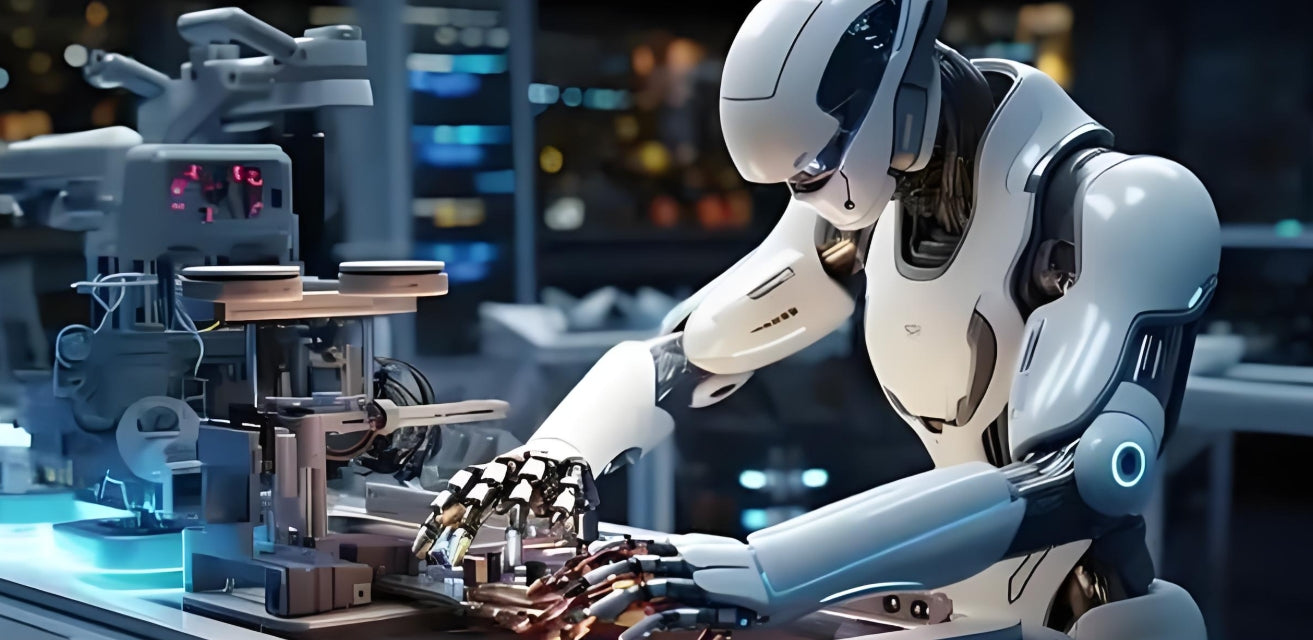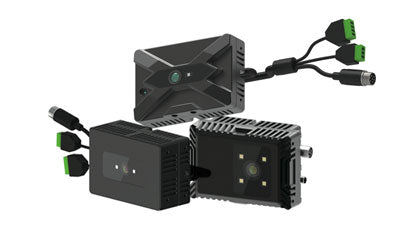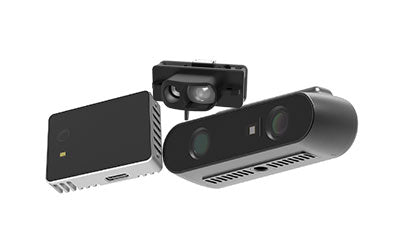AI Robots Evolve with TOF for Better 3D Sensing and Path Planning

With the rapid development of artificial intelligence (AI) and robotics, intelligent robots are being widely applied in industries, households, and public services. However, robotic vision systems still face bottlenecks such as insufficient environmental perception accuracy and weak understanding of 3D space. As one of the advanced 3D imaging technologies, TOF (Time of Flight) depth cameras are emerging as a key technology to advance the evolution of intelligent robots due to their high-precision, real-time depth measurement capabilities.
Current Bottlenecks in Robot Vision
At present, most intelligent robots rely on traditional RGB cameras and 2D image processing to perceive their environment. However, they are often limited by lighting changes, occlusions, and other factors, making it difficult to accurately obtain the spatial position and shape of target objects. This challenge is especially evident in autonomous navigation and obstacle avoidance in complex environments. Industrial automation, warehouse handling robots (such as AGVs), and service robots, in particular, require more accurate 3D environmental understanding to enhance path planning and operational efficiency.
TOF Enables Real-Time High-Precision 3D Mapping, Enhancing Autonomous Navigation and Obstacle Avoidance
TOF (Time of Flight) 3D depth cameras measure the time it takes for a light signal to travel from the emitter to the object surface and back, obtaining the distance information of each point in the environment. This generates high-resolution, real-time depth maps. This flight-time-based distance measurement technology significantly improves the precision and completeness of spatial data, allowing robots to reconstruct detailed 3D models of complex environments.
Combined with advanced 3D SLAM (Simultaneous Localization and Mapping) algorithms, robots can not only acquire 3D structures of the environment in real time but also continuously update their maps during movement. This ability to 'map while moving' allows precise self-localization, enabling strong autonomous navigation and flexible path planning. Robots can avoid dynamic obstacles efficiently, ensuring safe and effective operations. This is particularly beneficial in industrial automation, warehouse logistics, and service robot applications, where the advantages of TOF combined with SLAM are especially pronounced, greatly enhancing the intelligence level of robots.
In addition, TOF sensors offer key advantages such as compact size, low power consumption, and strong resistance to light interference. These features make them easy to integrate into various robotic platforms, including mobile robots, autonomous vehicles, and drones. Such characteristics not only reduce overall hardware costs and energy consumption but also improve the reliability and adaptability of devices, making TOF an essential component of the 3D machine vision market.
As 3D vision technology continues to mature and application scenarios diversify, TOF depth cameras will play an increasingly important role in enabling efficient robotic perception and intelligent decision-making, helping the robotics industry achieve higher levels of automation and intelligence.
How Big Is the 3D Machine Vision Market?
As of 2024, the global 3D machine vision market is growing rapidly, with its value estimated to reach several billion USD. According to industry research reports, between 2023 and 2028, the compound annual growth rate (CAGR) of the 3D machine vision market is expected to be around 10% to 15%, with market size steadily expanding over the next few years.
This growth is driven by the upgrade of manufacturing automation, advances in robotics, and the widespread application of TOF 3D sensors and 3D vision systems in industrial inspection, autonomous driving, warehouse logistics, and intelligent robots.
Specifically, some authoritative forecasts suggest that the global 3D machine vision market will reach around USD 3–4 billion in 2024, with the potential to surpass USD 7 billion in the next five years.
The large and rapidly growing 3D machine vision market is a major driving force behind the upgrade of smart manufacturing and robotics.
Application Scenarios: Home Service, Warehouse Handling, and Patrol Robots
With the rapid advancement of intelligent technologies, TOF (Time of Flight) 3D sensors are being widely applied in various types of robots, significantly enhancing their environmental perception and autonomous behavior—especially in home service, warehouse handling, and security patrol domains.
Home Service Robots
Home service robots equipped with advanced TOF 3D sensors can scan indoor environments in real time, accurately identifying furniture, walls, people, and other obstacles to reconstruct a 3D model of the surroundings. This enables the robot to plan cleaning routes intelligently, avoid furniture and pets, and adjust its actions based on scenarios—for example, avoiding people while delivering food or locating its charging dock automatically. The high-precision 3D depth data provided by TOF sensors ensures stable operation in complex indoor environments, greatly enhancing user experience and home intelligence.
Warehouse Handling Robots (AGVs)
Warehouse handling robots, or Automated Guided Vehicles (AGVs), are a vital part of modern warehouse automation. With the help of TOF depth cameras, AGVs can accurately identify the shape, size, and position of goods, allowing for comprehensive environmental awareness. By combining various AGV navigation methods, such as laser navigation, visual navigation, and inertial navigation, AGVs can autonomously plan optimal paths and avoid dynamic obstacles to ensure safe and efficient cargo transport. The real-time depth data from TOF sensors significantly reduces human error and safety risks in traditional warehouse operations, accelerating the shift toward unmanned and intelligent logistics.
Patrol Robots
Patrol robots, which serve as intelligent devices for security monitoring and environmental inspection, are commonly equipped with both TOF and 3D LiDAR sensors. These tools allow for precise environmental sensing and dynamic obstacle detection. TOF sensors provide detailed 3D depth data that help the robot perform round-the-clock patrols in complex indoor or outdoor environments.
3D LiDAR adds long-range, high-accuracy scanning capabilities that help build detailed 3D maps and support SLAM robot navigation, improving autonomous navigation and obstacle avoidance. Through sensor fusion, patrol robots can detect abnormal behavior, trigger intrusion alerts, and support real-time video surveillance, becoming a key part of smart security systems.
Empowered by TOF 3D sensors, intelligent robots are transforming home service, warehouse logistics, and security patrol with precise 3D imaging and advanced navigation algorithms. In the future, as the 3D machine vision market continues to grow and semiconductor technology advances, robots based on TOF and 3D LiDAR will become smarter and more reliable, driving intelligent manufacturing and smart living to new heights.
Integration with SLAM Systems: A Key Breakthrough in Enhancing Robotic Autonomous Navigation and Obstacle Avoidance
As robotics technology advances rapidly, single-sensor systems are no longer sufficient to meet the needs of accurate perception and intelligent decision-making in complex environments. The deep integration of TOF (Time of Flight) depth sensors with advanced SLAM (Simultaneous Localization and Mapping) systems has become a crucial technical path for improving robotic autonomy and obstacle avoidance capabilities.
TOF sensors can capture high-precision 3D depth data in real time, helping robots construct detailed 3D models of their surroundings. Combined with AI-driven semantic recognition technologies, robots can not only 'see' the spatial structure of the environment but also 'understand' the various objects within it. For example, through a 3D vision system, a robot can distinguish between people, furniture, shelves, doors, and windows, and even determine their dynamic status (such as a moving pedestrian or a static obstacle).
This ability to achieve environmental semantic understanding enables robots to perform smarter and safer path planning, effectively responding to dynamically changing and complex scenarios with real-time obstacle avoidance and task optimization.
Moreover, the fusion of TOF sensors with visual SLAM systems leverages the complementary strengths of both technologies. Visual SLAM relies on rich texture information from camera images, which works well in environments with abundant features and good lighting. In contrast, TOF sensors offer powerful active distance measurement capabilities, maintaining high-accuracy depth perception even in low-light or variable lighting conditions. By combining both, robots gain enhanced stability and robustness for localization and mapping across diverse environments and lighting conditions.
This integration not only optimizes autonomous path planning but also significantly boosts the real-time responsiveness and accuracy of obstacle avoidance. It greatly enhances a robot’s adaptability in both indoor and outdoor scenarios. For 3D robotics companies, adopting a fusion of TOF and visual SLAM technologies is a critical step toward upgrading product capabilities and improving market competitiveness.
Looking ahead, as computing power and AI algorithms continue to evolve, the deep integration of TOF and SLAM will lead to more intelligent, autonomous, and safer robotic systems. These systems will be widely applied in smart manufacturing, warehouse logistics, security patrol, and service robotics, propelling 3D robotics technology to new heights.
AI Semantic Recognition + TOF Sensing: Building 'Understandable' Environments for Intelligent Robotic Decision-Making
By leveraging high-precision 3D depth data from TOF sensors and combining it with advanced deep learning and AI semantic recognition techniques, robots can perform fine-grained scene segmentation and semantic analysis. This means they can not only perceive the geometric structure and spatial layout of their surroundings but also 'understand' specific objects and their attributes, enabling a deeper level of environmental cognition.
Through AI semantic recognition, robots can automatically distinguish and identify various object types in their environment—such as humans, machinery, cargo, and obstacles—and even assess their status and movement. For instance, in a warehouse setting, robots can accurately identify different types of pallets, boxes, and goods, achieving efficient object localization and path planning. In manufacturing, robots can detect surface defects on products with high precision, enabling automated 3D vision inspection that significantly improves production quality and efficiency.
This 'understandable' perception capability lays a solid foundation for intelligent interaction and autonomous decision-making. Based on recognition results, robots can flexibly adjust their behavior strategies to complete complex tasks such as AI-driven palletizing, smart handling, anomaly detection, and safety alerts. With the deep fusion of AI and TOF sensing, robots evolve from passive executors of tasks to intelligent agents with environmental understanding and autonomous reasoning abilities.
In the future, as AI algorithms and TOF hardware performance continue to improve, this integrated technology will enable broader applications of intelligent robots in smart factories, automated warehouses, unmanned retail, and visual quality inspection. Robots will be better equipped to handle dynamic environments, achieving more efficient, safer, and more autonomous operations—driving industrial automation into a new era of intelligence and precision.
Conclusion
TOF 3D depth cameras, with their high-precision and efficient spatial sensing capabilities, are becoming a crucial bridge in helping robots move from merely 'seeing' their environment to truly 'understanding' it. With the deep integration of 3D SLAM, AI semantic recognition, and robotic vision systems, the future of robotics will see qualitative leaps in autonomous navigation, path planning, and human-machine interaction. These advances will bring revolutionary changes to fields such as smart manufacturing, intelligent logistics, and smart security.
Synexens 3D Camera Of ToF Sensor Soild-State Lidar_CS20
After-sales Support:
Our professional technical team specializing in 3D camera ranging is ready to assist you at any time. Whether you encounter any issues with your TOF camera after purchase or need clarification on TOF technology, feel free to contact us anytime. We are committed to providing high-quality technical after-sales service and user experience, ensuring your peace of mind in both shopping and using our products





